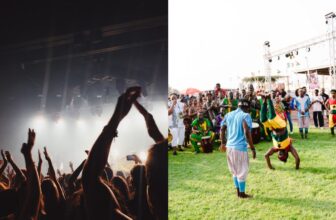Do Looks Matter In The Music Industry?

Looks matter in the music industry, but not because musicians need to be attractive. Looks can help artists to brand their songs, position themselves in a niche, express themselves visually, and create new beauty standards. It’s not about your face and body, it’s about how you present yourself.
The idea that musicians need to be attractive to be successful is a myth. Looking back at the history of popular music in the 20th century, one can think of countless examples of successful musicians who failed to meet the beauty standards of their era. On the contrary, many found success precisely because they presented themselves in a shocking, unique, and even purposely “ugly” way.
Looks can help to make or break an artist, but they’re not what music is fundamentally about. With enough talent, even the most bland-looking of musicians can find fame and fortune in the music industry.
Contents
Why are looks so important in the music industry?
For better or worse, music is entertainment. It’s never just about the sound, it’s also about the show. Just like records need a record cover, musicians need a presence.
Because looks will always be an inescapable part of a musician’s career, you should learn more about the four main reasons why looks matter in the music industry:
1. Looks help artists sell songs
You shouldn’t listen to a musician solely because he or she looks good. But more often than not, looks are crucial for helping musicians to sell songs. I’m not saying that more attractive artists sell more (even though that’s sometimes the case), but simply that the way a musician looks directly influences the number of records he or she sells.
For one, looks are crucial for setting musicians apart from one another. Imagine you step into a record store and stumble upon two folk records from unknown artists. One looks plain and boring, and the other is stylish and exciting. What record would you most likely buy?
From a branding standpoint, looks are also what helps artists to have ‘their thing’. Think of Lady Gaga when she first showed up. Even though she sang some pretty catchy songs, would she be as successful without her extravagant outfits and far-fetched dresses?
Even musicians who hide the way they look do so because looks matter. The pop singer Sia felt like she needed to distance herself from other female pop singers, so she chose not to reveal her face. Daft Punk, the ultimate example of anonymity in music, did the same years before, with the plus of relying on some pretty cool robot suits.
2. Looks help artists define their sound
You don’t necessarily need to dress in black and have corpse paint on your face to make high-quality metal grindcore. And you can be pretty modest with your dress sense to become a major pop singer. Yet, the way one artist looks is crucial in defining the way they sound from the get-go.
Certain musical niches are associated with certain pre-established looks because that’s extremely helpful. It’s like high school, back when you knew that the kids wearing Vans would probably be into skating, or that the kids with dreadlocks probably enjoyed Bob Marley’s music.
When an experienced music fan steps into a record store, he or she can easily guess the genre of most records based on their cover alone. Colorful ’60s-style drawings with big, chunky logos? That’s psychedelic rock! A laidback picture of a guy in a suit standing next to a piano? Surely a classical music record. Well, artists themselves are a bit like record covers.
If you want to make hip-hop and sell lots of hip-hop records, it helps, from a commercial standpoint, to look like a hip-hop artist. Sure, you want to distance yourself from the competition too; but you don’t want to go completely against your style. It’s cool to dress according to your niche and add a twist, but it’s not so cool to go completely off the rails.
3. Looks are a creative extension of an artist’s music
The way a music act presents itself is a creative, artistic choice. It’s an extension of the music, just like a record cover, a music video, or a piece of merchandise. You can look any way you want to in your day-to-day life; but once you step onto the stage or show up for a photoshoot, you are a creative extension of your music whether you like it or not.
Some of the most successful artists in the world were extremely aware of this. Marilyn Manson wanted to make some provocative industrial rock, and that’s precisely what he did. But think about it: would his provocativeness be half as effective if he didn’t dress in such a strange, eerie manner? Would his songs sound as disturbing to a mainstream audience if he wore jeans and a flannel shirt like Kurt Cobain?
If you want to deliver a message with your music, you need to express such a message in every little thing that surrounds your music: including the way you look. If you want your music to sound pretty and cozy, dress pretty and cozy; if you want it to sound futuristic, put on some futuristic clothes; and if you want it to be shocking, do your very best to impress anyone watching.
4. Looks can help to set new beauty standards
The best musicians are iconic, and they can change the world with their songs. But they can also change the world with their looks. Time and time again, artists have been at the forefront of the fight against discrimination, setting new patterns for what should or shouldn’t be accepted by the overall society.
In sum, iconic musicians become new beauty standards. Think of David Bowie and Prince, for example. They often dressed androgynously, and their superstar status helped to normalize subcultures that did so. Prince made it okay (and even cool) for a man to look flamboyant and even feminine without having any of his “manliness” challenged by the rest of the world. He redefined masculinity.
More recently, artists like Lizzo made a great contribution to the female body-positivity movement that continues to grow online.
What can a musician do to look good?
- Start by accepting that your musician’s persona shouldn’t necessarily look the way you do in your day-to-day life;
- Identify the fundamental message you’re trying to share with your music and translate it into a certain look;
- Don’t ignore your music niche. You don’t want to show up dressed as a choirboy to your next hip-hop gig;
- Be creative with the way you dress or present yourself. Try to find something unique, something that sets you apart from everyone else;
- If you’re shy, wearing a mask or concealing outfit is always a good idea. It’ll not only help you to be more comfortable on stage but it will also make you look more mysterious and fascinating;
- Ignore what the overall society considers to be beautiful. The greatest musicians were never afraid to go against the norm;
- Finally, just take good care of yourself. Try to eat healthily and keep your body in shape. Being attractive isn’t the main thing, but it’s never a bad thing either.
Conclusion
Looks aren’t everything but they are a lot. Through time, musicians have pushed the envelope of what is considered socially acceptable in terms of fashion and appearance. Some have even managed to set new standards for beauty.
While it’s important to take care of yourself, the most important thing is to be creative and unique in your presentation. Don’t be afraid to go against the grain and dress or look however you want – the world’s most iconic musicians certainly didn’t.





